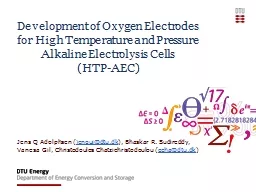

E lectrodes for High Temperature and Pressure Alkaline Electrolysis Cells HTPAEC Jens Q Adolphsen jenquidtudk Bhaskar R Sudireddy Vanesa Gil Christodoulos Chatzichristodoulou ID: 794064
Download The PPT/PDF document "Development of O xygen" is the property of its rightful owner. Permission is granted to download and print the materials on this web site for personal, non-commercial use only, and to display it on your personal computer provided you do not modify the materials and that you retain all copyright notices contained in the materials. By downloading content from our website, you accept the terms of this agreement.
Slide1
Development of Oxygen Electrodes for High Temperature and Pressure Alkaline Electrolysis Cells (HTP-AEC)
Jens Q Adolphsen (
jenqui@dtu.dk
), Bhaskar R. Sudireddy,
Vanesa Gil
, Christodoulos Chatzichristodoulou
(
ccha@dtu.dk
)
Slide2OutlineECerS conference 2017, Budapest2Motivation for the workSelection of materialsElectrochemical activity towards the OERChemical stability of materials at high temperatureProcessing porous LaNi0.6Fe0.4O3 electrodes
2017-07-13
Slide3High Temperature and Pressure Alkaline Electrolysis Cells (HTP-AEC)ECerS conference 2017, Budapest3Mesoporous Electrolyte matrixRecord data from earlier work3.75 A/cm2 at 1.75 V with
η
el
= 85 % (
200ºC
, 20 bar)
C.
Chatzichristodoulou
et al. J.
Electrochem
.
Soc
, 163, 2016
2017-07-13
Slide4Selection of materials for the OERElectrochemical activityElectrochemical stabilityElectronic conductivity4
Activity
Stability
Electrode materials for
t
he
Oxygen Evolution
R
eaction (OER
)
4
OH
-
aq
O
2(g)+2H2O(l)
4e
-
?
Slide5Electrochemical CharacterizationMaterialsConditionsRTP, N2 atmosphere, 1 M KOH, MeasurementsChronopotentiometry at 0.5, 1.0, 2.0, 5.0, 10, 25 and 50 mA·cm-2Amperostatic EIS 5Reference electrode (RHE from Gaskatel)
Working
electrode
(
Au
current collector
)
Counter electrode (Pt mesh)
Separator
LaNiO
3
La
0.97
NiO
3
LaNi
0.6
Fe
0.4
O
3
La
0.97
Ni
0.6
Fe
0.4
O
3
La
2
Ni
0.9
Fe
0.1
O
4
Slide6Electrochemical Characterization6
Slide7Electrochemical Characterization7Materialb (V/dec)
η
(V)
@
10 mA/cm
2
LaNiO
3
0.083
0.38
La
0.97
NiO
3
0.092
0.44
La
Ni
0.6
Fe
0.4
O
3
0.13
0.44
La
Ni
0.6
Fe
0.4
O
3
0.11
0.45
La
2
Ni
0.9
Fe
0.1
O
4
0.079
0.40
IrO
x
[1]
-
0.32
Ni
0.9
Fe
0.1
O
x
[2]
0.030
0.34
Pr
BaCo
2
O5+x [3]~0.07~0.38
[1]
C. C. L.
McCrory
, S. Jung, J. C. Peters, T. F.
Jaramilllo
, J. Am.
Chem
. Soc. 135 (16977-16987), 2013
[2]
L.
Trotochaud
, J. K.
Ranney
, K. N. Williams, S. W.
Boettcher
, J. Am.
Chem
Soc. 134 (17253-17261), 2012
[3]
A.
Grimaud
, K. J. May, C. E. Carlton, Y-L. Lee, M.
Risch
, W. T. Hong, J. Zhou, Y.
Shao
-Horn, Nat.
Commun
. 4 (2439-2445), 2013
Slide8Electrochemical Characterization8
Slide91 µmSample roughness factors9Initial polished surfacePolished surface after electrochemical testing1 µm
1 µm
Sample
R
RMS
(pre) [µm]
R
RMS
(post)
[µm]
LaNiO
3
0.41
0.79
La
0.97
NiO
3
0.44
0.92
LaNi
0.6
Fe
0.4
O
3
0.37
0.68
La
0.97
Ni
0.6
Fe
0.4
O
3
0.38
0.49
La
2
Ni
0.9
Fe
0.1
O
4
0.20
0.81
Slide10Chemical StabilityPorously sintered pellets and as-received powders exposed toconcentrated KOH for a week at 100°C/220°C 10
Slide11Chemical Stability – XRD 11○LaNiO3 ● LaNi0.6Fe0.4O3 Δ La2Ni0.9Fe0.1O4 + La2O3 ♦ LaO(OH) ♠ La(OH)3
*
NiO
□
NiO
(OH
)
♥
Ni(OH)
2
× Fe
2
O3 ◊ FeO(OH) ♣ Fe(OH)2
Slide12Chemical Stability – XRD12○LaNiO3 ● LaNi0.6Fe0.4O3 Δ La2Ni0.9Fe0.1O4 + La2O3 ♦ LaO(OH) ♠ La(OH)3
*
NiO
□
NiO
(OH
)
♥
Ni(OH)
2
× Fe
2
O3 ◊ FeO(OH) ♣ Fe(OH)2
Slide13Processing of LNF electrode layersProcessing of porous structures for the oxygen evolution reaction - 40-50% total porosity - Hierachical porosity macropores & mesoporesOptimization of the microstructure of the porous electrode: - Allow transport of oxygen leaving the pores - Allow transport of OH- species to reactive sitesOptimal pore size distributionPercolating phases (gas, solid)13MesoporosityMacroporosity
Slide14Processing of LNF electrode layers1410 µm200nm
2
00 µm
Slide15Processing of LNF electrode layers1510 µm10 µmTop surface
Cross section
Slide16AcknowledgementsBent F. HansenJeanette KrambechJens ØstergaardKaren BrodersenKjeld B. AndersenLene KnudsenSøren ChristensenSøren P. V. Foghmoes16Thank you for your attention